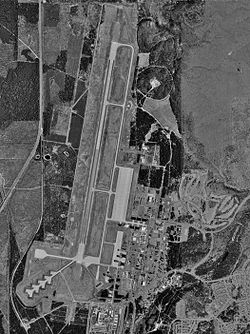
The 410th Bomb wing Had control over K.I Sawyer Air force Base from January 1, 1964 until the base’s closure in 1995. The 410th was a group of bombers, training, in-flight refueling, and maintenance crews; who’s job was to be ready at all times and had many aircraft at their disposal including the KC-135A in air refueling “Stratotankers” and several B-52 Bombers. The 410th was active during the cold war, the Vietnam war, and even had missions to Southeast Asia; of note was “Operation Arc Light”.
The Glider
In August 1969, During a training exercise to Kincheloe Air Force Base near Sault Ste. Marie, a KC-135A was mistakenly instructed to lower its altitude to 5,000-6,000 feet drastically increasing its fuel consumption. After a bad approach to Kincheloe air force base it was decided that they should turn around and refuel at the K.I. Sawyer base due to fuel concerns. Around Munising the engines started to experience fuel starvation in the engines, the Instructor pilot attempted to idle two of the engines and mistakenly turning them all the way off; then restarting them, using more fuel. Heading west over Skandia it became clear that the fuel shortage was now a serious problem, the Instructional pilot now tuning off the two engines, he had minutes prior restarted. The Co-pilot had prior requested a “Mayday” only to have the Instructional pilot state, “We do NOT have an emergency”. Moments later the engines fell silent and the pilot instructed the crew to prepare to bailout. The co-pilot blew the door as the entire crew had already strapped into their chutes. Everyone bailed except for the two pilots and the navigator. As the pilot was saying nothing, and frantically messing with the panel which was illustrating a fuel reserve of “Empty” the co-pilot bailed, saying, “I’m out of here, sir” and shortly after so did the navigator, Joe Roads.
The crew landed on a pine forest and survived the jump, the aircraft touched down just short of the runway, skidding onto the main landing strip suffering relatively minor damages to the landing gear. The 600 or so pounds that was ejected from the plane may have been the saving grace for the plane. The KC-135A ( AF Serial No. 61-0313) became affectionately known as “The Glider” because of this incident, and was fully repaired in a matter of weeks. Reportedly even the door, which was blown off during the crew’s bailout, was returned to the plane by a local farmer who found it in his field.
Unfortunately such luck was not “The Normal” out at K.I. Sawyer, there are many documented crashes of various aircraft that crashed on landing or takeoff despite it’s massive runway any favorable surrounding tree line. Several of these crashes at K.I. Sawyer were KC-135’s and the crewmen knew they were very lucky. One example being in September 26. 1976, where a KC-135 went down over the upper peninsula killing 15 of its crewmen.
The Boeing KC-135A
The KC-135A is a member of the KC-135 family of jet powered aircraft manufactured by Boeing from 1955-1965. The aircraft have saw continuous usage since their installation and are projected to be in service until 2030. The “A” in the name reduces the empty weight of the aircraft from 115,000 lbs to 104,000 lbs, and allows the aircraft to carry 200,000 lbs of fuel compared to the “E” designations 190,000 lb rating. This serves the aircraft well since their primary purpose is in flight refueling.

The KC-135’s though seem to be somewhat prone to incident according to those who have flown and researched them. There was an incident with one K.I. Sawyer KC-135 where it lost cabin pressure just after take off, as a result the crew decided to fly at a lower altitude restoring pressure to the cabin. The KC-135 was in route to Wurtsmith air force base in eastern Michigan to pick up officers for a first team visit. The aircraft unfortunately struck high terrain 12 miles south west of Alpena, MI. The KC-135 was completely destroyed but somehow five of the twenty crewmen on board managed to survive the grave incident. The direct cause of this crash was never found despite months of investigation and several eyewitness reports.
There are approximately a dozen reported incidents with just KC-135’s departing, arriving, in route to or from K.I Sawyer Air force base who had a catastrophic incident such as a crash. All of which show just how lucky “The Gliders” crew was to have survived with both crew and aircraft (mostly) intact.
K.I. Sawyer & The 410th Bomb Wing
Since K.I. Sawyer’s construction in 1944 the sight has seen many changes, mostly in the form of expansion. The sight start off for private flight use and didn’t see it’s first military interest until 1954 when the air-force announced a massive $12,000,000 expansion, ultimately turning the space into a military only sight in 1956. Once the expansion was complete K.I. was home to the 473rd

Also, be sure to visit other post involving K.I. Sawyer Air-force base as it was a fascinating place of military activity throughout the cold war era.
Primary Sources
- Roads, Joe. “Night of the Gliding Pig.” JoeRoads.com: The Official Blog of Author Joe Heywood [Blog], 25 Feb. 2008,
- Hoctor, Christopher J. B., and Paul J. Selva. Voices from an Old Warrior: Why KC-135 Safety Matters. Galleons Lap, 2014.
- “Survivors Mark 40th Anniversary of Air Force KC-135 Crash.” Military Times, Military Times, 8 Aug. 2017.
Secondary Sources
- “K. I. Sawyer Air Force Base.” Academic Dictionaries and Encyclopedias, Enacademics , .
- “SAC Bases: K. I. Sawyer Air Force Base.” K.I. Sawyer AFB – SAC – 410th Bomb Wing – B-52, Strategic Air Command, .
- “Quick Links.” History Timeline | K.I. Sawyer Heritage Air Museum, K.I. Sawyer Heritage Air Museum.

